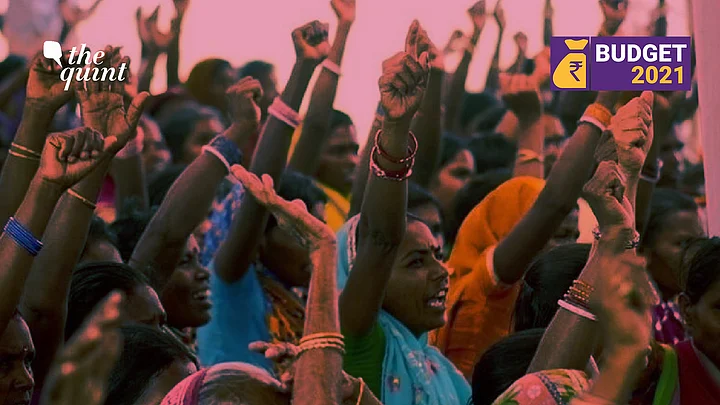The COVID-19 pandemic exposed three important areas of gender inequality:
- High levels of domestic violence faced by women
- Disproportionately high unpaid care work by women
- Poor remuneration, working conditions, and safety provisions of frontline workers, a majority of whom are women
Besides, women suffered higher proportionate job losses on account of the economic crisis.
A logical expectation therefore – from a welfare perspective and the perspective of equality – was that the Union Budget 2021 would address these inequalities. The Budget, presented by Finance Minister Nirmala Sitharaman on Monday, 1 February, does offer some substantial allocations towards fulfilling some of these expectations, but some others, it appears, remain unmet.
Gender Budget Just 4.3% of Total Outlay, Less Than Previous Year
The gender budget shows the funds dedicated to women-specific schemes, where at least a third of those who benefit are women.
Gender budgets have continued to remain under 5 percent of the total Union Budget since the exercise was made mandatory in 2006. This year, the gender budget is 4.3 percent of the total budget outlay – below the 4.7 percent of 2020-21.
The outlay for women-specific schemes in the Women and Child Development Ministry saw a decrease from a budget estimate of Rs 3,919 crore in 2020-21 to Rs 3,310 crore in this budget, a reduction of 15 percent.
Therefore, it would appear that much more would be required to substantially increase the overall outlay for budgets and schemes which directly benefit a large number of women.
As per the Oxfam India’s report, ‘The Inequality Virus’, gender inequalities were among those which increased to unprecedented levels during the COVID crisis. Domestic violence faced by women recorded a 10-year high between March and May 2020, when the sudden and unplanned lockdown forced women to be trapped at home with abusive spouses and marital families.
During the same time, the Domestic Violence Act, 2005 (Protection of Women from Domestic Violence) came to a virtual shutdown. Women could not approach protection officers or the courts for protection orders or emergency injunctions against the violence, a critical measure provided by the law.
Similarly, women were unable to access crisis support centres for women due to the lockdown.
Drastic Drop In Funds For Women Welfare
Against this backdrop, it is surprising to see that the budget outlay under the ‘Mission for Protection and Empowerment of Women’ saw a drastic cutback to Rs 48 crore, as compared to Rs 901 crore in 2019-20 and Rs 1,163 crore in 2020-21.
This scheme is part of an umbrella scheme to provide for technical and other assistance in running several key government programmes. This includes ‘One Stop Centres,’ the flagship government programme to address violence against women, Ujjwala Scheme to support women who have been trafficked, and ‘Beti Bachao Beti Padhao’ for the empowerment of girls.
This mission was also charged with coordination between different ministries to synergise schemes for women, capacity building for different ministries to effectively integrate gender concerns in their working, and capacity building of stakeholders, such as the police, in gender-sensitive approaches to their work.
There is no allocation for ‘One Stop Centres,’ women helpline, and shelter homes. The assistance to other schemes from the Nirbhaya fund is the only place where the Rs 48 crore is allocated – and that is a drastic reduction from the revised budget estimate of 2020-21 of Rs 303 crore.
While a substantial amount of Rs 3,109 crore is provided under ‘Mission Shakti,’ since a number of schemes for women and children are clubbed under the heads of schemes like ‘SAMBAL’ and ‘SAMARTHYA,’ it is difficult to evaluate where the money will finally flow.
Feminist economists have opined that there is actually an overall decrease in allocations to women’s schemes.
No Mention of Unpaid Care Work By Women, Ignores Education For Girls
The other persistent areas of inequality include women’s unpaid care work, which being highly unequal in ‘normal’ times (clearly not normal for women), increased phenomenally during the COVID-19 crisis.
Women spend about 10 times as much time as do men in cooking, cleaning, and looking after children and the elderly. While women’s participation in paid work continues to fall in India, unpaid care work is recognised as one of the primary reasons why women are not free to put in more hours of paid work.
At the same time, girls’ education, skilling for women and girls, and facilitating jobs and livelihoods for women is an important priority that the budgets can address, but there is nothing significant to that effect in this budget.
ASHA Workers’ Role During Pandemic Not Recognised
The ASHA and Anganwadi workers played a stellar role during the COVID crisis. Not only did they rise to the occasion, but their work hours and responsibilities too increased, with many facing risks to their safety.
On the other hand, as per their employment terms, the government does not consider them workers but rather as ‘volunteers’ paid on the basis of incentives as per tasks accomplished. This work appears to be just an extension to the ‘unpaid care work’ that all women are unfairly expected to provide.
The COVID circumstances led to many unions of these workers to protest for minimum wages and better working conditions.
According to Oxfam’s inequality report, if India’s top 11 billionaires are taxed at just 1 percent of their wealth, it would pay the average current wage of 9 lakh ASHA workers in the country for five years.
However, such measures to generate revenue to bridge inequalities have not been explored in the budget at all.
(Amita Pitre is the Lead Specialist, Gender Justice at Oxfam India. This is an opinion piece and the views expressed above are the author’s own. The Quint neither endorses nor is responsible for the same.)
(At The Quint, we question everything. Play an active role in shaping our journalism by becoming a member today.)
